![]()
![]()
![]()
Use LEFT and RIGHT arrow keys to navigate between flashcards;
Use UP and DOWN arrow keys to flip the card;
H to show hint;
A reads text to speech;
32 Cards in this Set
- Front
- Back
|
-Reduced Keel (can fly) -4 toes -Chicken-like bills -C. & S. America
|

Tinamiformes -Tinamous
|
|
|
-Largest bird -Fastest Runner -Reduction to 2 toes -Feathers not in tracts nor neck nor head -Found in Africa only |

Struthioniformes (Ratites) -Ostrich |
|
|
-Long wings with strong claw on each -3 toes only -Feathered neck and head -Good eyesight and hearing -S. America |

Rheiformes (Ratites) -Rhea |
|
|
-3 toes -Aftershaft almost as long as main feather -Flat bill -Australia |

Casuariiformes -Emu -Southern Cassowary |
|
|
-No rectrices -No aftershafts -Hair-like feathers -Huge Eggs -Nocturnal (poor eyesight, good hear/smell) -4 toes -Flexible bill, nostrils at tip, valves at base -New Zealand |
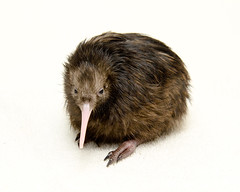
Apterygiformes -Kiwi |
|
|
-Aquatic/semi-aquatic (swim and fly) -Webbed feet, short-legs -Long-neck -Precocial young -Worldwide |
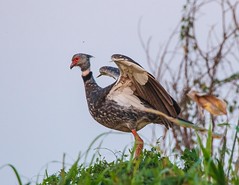
Anseriformes -Anatidae: Swans, Geese, Ducks -Anhimidae: Screamers |
|
|
-Medium to large terrestrial species -Strong legs, heavy feet, hind tow -Bill short, conical, curved culmen -Large clutches -Precocial young -Worldwide |

Galliformes -Grouse, Turkey, Quail, Ptarmigan, Pheasant |
|
|
-Aquatic, duck-like -Breed in fresh water, winter on ocean -Legs far back on body -3 front toes fully webbed -Spear-shaped bills -Plumage heavy and waterproof -Holartic |

Gaviiformes -Loons |
|
|
-Flightless, but well-developed keel -Flattened wings with fused bones (flippers) Plumage dense and waterproof, no tracts -Webbed feet, far back on body -Southern Hemisphere |
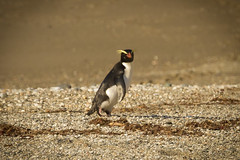
Sphenisciformes -Penguins
|
|
|
-Tube-nosed seabirds -Hooked bill -Plumage dense, waterproof -3 front toes webbed -All oceans |
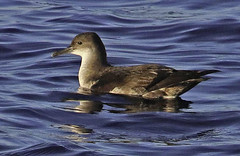
Procellariformes -Petrels, Shearwaters, Storm-Petrels, Albatrosses |
|
|
-Aquatic, diving fish-eaters (foot propelled) -Legs far back on body -Tail reduced -Plumage ense, satiny, waterproof -Eat own feathers -Worldwide |

Podicipediformes -Grebes |
|
|
-Wading birds, long legs and necks -Bill bent downward in middle, serrated edges -Movible maxilla, rigid mandible -Webbed front toes -Tropics |
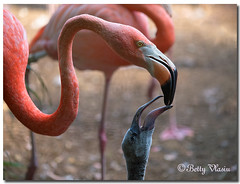
Phoenicopteriformes -Flamingos |
|
|
-Pelagic (open ocean) -Plunge-diving fish-eaters -Very long tails -Bills strong, stout -Largely White -Tropical |

Phaethontiformes -Tropicbirds |
|
|
-Large, long legs and necks -Bill long, stout -Lack syrinx (mute) -Thermal soaring, gliding flight -Stick nests
|

Ciconiiformes -Storks |
|
|
-Medium to large aquatic birds -Webbed feet -Colonial Nesters -Worldwide |
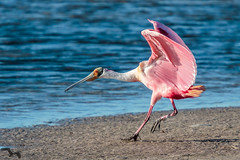
Pelicaniformes -Threskiornithidae: Ibises, Spoonbills -Ardeidae: Herons, Bitterns, Egrets -Pelecanidae: Pelicans |
|
|
-All four toes webbed (totipalmate) -Aquatic -Bare gular patch (throat sac) |
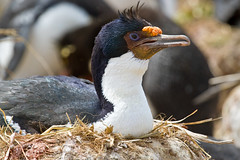
Suliformes -Fregatidae: Frigatebirds -Sulidae: Gannets & Boobies -Phalacrocoracidae: Cormorants -Anhingidae: Anhinga |
|
|
-Sharp, pointed, heavily curved culmens -Carnivorous -Cosmopolitan distribution |
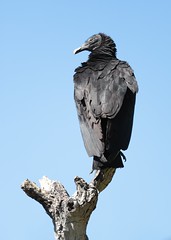
Accipitriformes -Accipitridae: Hawks, Eagles -Cathartidae: New World Vultures |
|
|
-Aquatic, shy, hard-to-see -No crop -Shared features of palate and skeleton -Worldwide |

Gruiformes -Cranes, Rails, Coots, Gallinules |
|
|
-Waders, swimmers, divers -Palate, syringeal muscles, vertebral column -Bear no outward Resemblance to each other -Worldwide |
Charadriiformes -Scolopacidae: Sandpipers -Charadriidae: Plovers -Recurvirostridae: Avocets & Stilts -Laridae: Gulls & Terns -Alcidae: Puffins, Auks, Murres & Guillemots
|
|
|
-Plump-bodes, small heads -Short bills, short legs -Large crop (produces milk) -Biparental care -Worldwide |
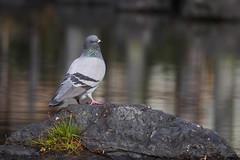
Columbiformes -Doves & Pigeons |
|
|
-Vegetarian -Large crop (for fermentation of leaves) -Weak flier -Wing claws in young -S. America |

Opisthocomiformes -Hoatzin |
|
|
-Slender, long tailed -Bill thick and down-curved -Zygodactyl feet -8-10 (vs 10-14) rectrices -Worldwide |

Cuculiformes -Cuckoos, Anis, & Roadrunners |
|
|
-Nocturnal birds of prey -Heavily decurved bills -Strong feet with sharp claws, zygodactyl -Facial disks concentrate sounds -Feathered legs and toes -Worldwide |
Strigiformes -Strigidae: typical owls -Tytonidae: barn owls |
|
|
-Nocturnal or crepuscular -Soft plumage -Long pointed wings, strong but erratic flight -Short weak legs and feet -Bill small with wide gape, long bristles -Worldwide |
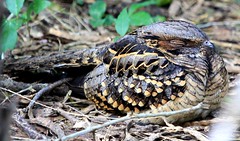
Caprimulgiformes -Nightjars, Nighthawks and allies (Pauraque) |
|
|
-Small with tiny feet -Accomplished fliers -Small humerus -10 long primaries, short secondaries
|
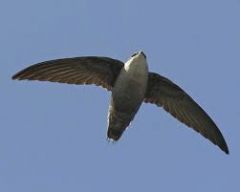
Apodiformes -Apodidae: Swifts -Trochilidae: Hummingbirds |
|
|
-Small, crested -Very long tails -Pamprodactyl (toes 1 and 4 reversible) -Africa |
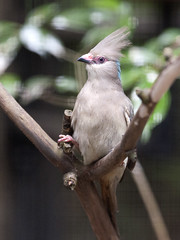
Coliiformes -Mousebirds |
|
|
-Bills short, wide -Fruit-eating -Short wings -Long tail -Small weak feet, heterodactyl (1&2 back, 3&4 up) -Pantropical |

Trogoniformes -Trogons & Quetzals |
|
|
-Stocky, large head, small feet -Gregarious and noisey, brightly colored -Syndactyl (2&3 partially fused) -Long prominent bill -Carnivorous -Altricial young |

Coraciiformes -Kingfishers, Rollers, Bee-eaters, Motmots, Todies |
|
|
-Zygodactyl (and unique tendon arrangement) -Barb-tipped tongues -Pointed, stiff rectrices -Altricial young -Worldwide |
Piciformes -Woodpeckers & Honeyguides, Toucans & Barbets, Jacamars & Puffinbirds |
|
|
-Wings long and pointed (fast flight) -Bill short and hooked -Eye-ring bare -Diurnal birds of prey -Sharp, curved talons -Semiprecocial young |
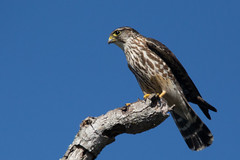
Falconiformes -Falconidae: Falcons |
|
|
-Large-headed, short-necked -Vocal -Heavy, hooked bills. Mobile maxilla -Short legs -Strong zygodactyl feet (perch and climb) -Pantropical |
Psittaciformes -Parakeets, Macaws, Parrots, Lories |
|
|
-Largest order (half of world´s birds) -Anisodactyl (3 up and 1 back) -Enlarged and flexible hallus -Spiral-shaped sperm -High metabolism -Bony palate, reduced number of neck vertebrae -Superior learning (relatively large brain) |
Passeriformes -Perching Birds |

